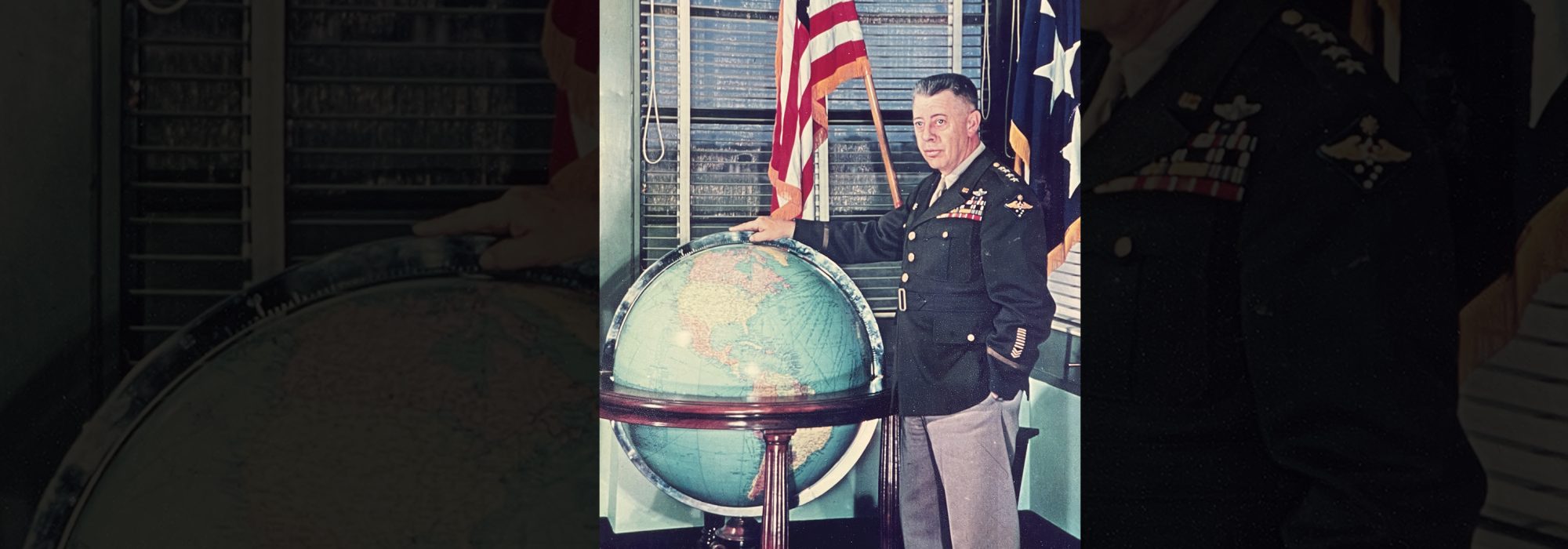Creator, Innovator, and Advocate for an Independent Air Force.
Kenney was known as “MacArthur’s Airman” due to his connection with the famous general during World War II. But Kenney was notable for more than that.
George attended MIT, but quit to join the Air Service when the U.S. entered the war in 1917. He became a pilot, and in France shot down two German aircraft, earning a Distinguished Service Cross and Silver Star. He returned to the States where he endured the slow promotions and budgetary austerity so prevalent at the time. He was an attack pilot—a first cousin to a pursuit (fighter) pilot—and taught at the Air Corps Tactical School at Langley Field in Virginia.
After Pearl Harbor, Gen. Douglas MacArthur needed someone to command his air forces. Kenney got the job and quickly won his boss’s trust and confidence. That is, once he got past his staff. Kenney told the story that MacArthur’s chief of staff started directing air matters—ignoring the air commander. Kenney went to his office, put down a piece of blank paper with a dot in one corner and said “the dot is how much you know about airpower; I’m the rest of the page. Let me do my job.”
Kenney tutored MacArthur on the characteristics and abilities of airpower, who quickly became a believer. When he was Army Chief of Staff from 1930 to 1934, MacArthur had not been an air advocate, but his opinion changed in war, and he stated in 1944: “I probably did the American Air Forces more harm than any man living when I was Chief of Staff by refusing to believe in the future of the airplane as a weapon of war. I am now doing everything I can to make amends for that great mistake.” MacArthur and Kenney were a close team.
Kenney had worked in the Engineering Division at McCook Field, Ohio, and this was important because it gave him a good understanding of aeronautics, aerodynamics, and engineering principles. These insights would be crucial when assigned to the Southwest Pacific where his air forces were at the end of a very long supply line. He used his initiative, creativity, and engineering experience to experiment and modify his aircraft to better their combat performance.
For example, one mission was to attack Japanese supply ships. This was not something the Air Corps had anticipated. Kenney took the radical step of modifying his B-25s by removing the plexiglass nose where the bombardier sat, and replacing it with a solid front that housed machine guns and a cannon. The result was an extremely effective ship killer. He also pushed the practice of skip bombing—an aircraft attacking a ship at low level and dropping the bomb so that it would skip across the water like a stone and hit a ship at its waterline.
The closeness between Kenney and his boss was not seen as a good thing in some quarters. MacArthur was a political general, and that tendency rubbed off. In March 1943 Kenney flew back to Washington for consultations with Army leaders. While there he met secretly with Republican Party officials to discuss the possibility of a MacArthur presidential run. Henry “Hap” Arnold heard of these meetings and was disturbed.
In March 1945 Kenney was promoted to full general—he was the ranking four-star Airman behind Arnold—and finished the war with a well-deserved outstanding reputation. When Arnold retired, Carl “Tooey” Spaatz was named his successor. This troubled Kenney somewhat because he outranked Spaatz, but when the youthful Hoyt Vandenberg was named Spaatz’s successor, he was seriously miffed. He told Vandenberg that he thought he should have been named Chief, but nonetheless, would support him faithfully.
Kenney took over Strategic Air Command (SAC), the premier operational job in the Air Force. Moreover, it was believed the United Nations would have its own air force, and Kenney was to be its commander as well. This did not occur, but while the notion was discussed, Kenney spent much time at U.N. Headquarters in New York City, away from his command.
When the Soviets blockaded Berlin in June 1948, war talk was rife. Vandenberg was concerned about SAC’s readiness—if war did break out, SAC would play a key role. He therefore sent three of his trusted agents, including Charles Lindbergh, on separate inspection tours of SAC. Their reports were not favorable. The Joint Chiefs of Staff summoned Kenney to give them a readiness briefing on his command. Kenney’s performance was poor—he seemed unprepared. Six days later Vandenberg relieved him as SAC commander, replacing him with Curtis LeMay.
Kenney served out his final years as Air University commander, retiring in September 1951. He wrote three books regarding his experiences in the war, the best being General Kenney Reports (Duell, Sloan and Pearce, 1949). His biography taking him through the war by Thomas E. Griffith, MacArthur’s Airman (Kansas, 1998), is excellent.
